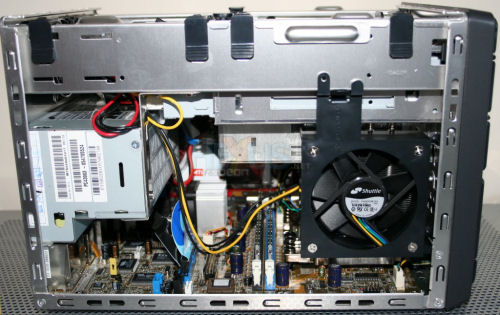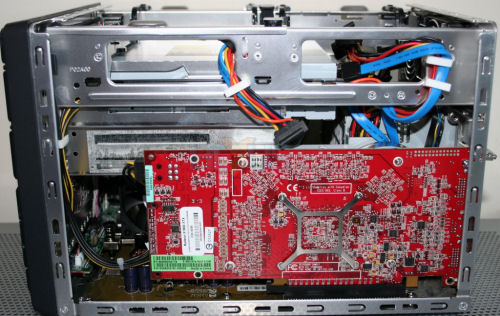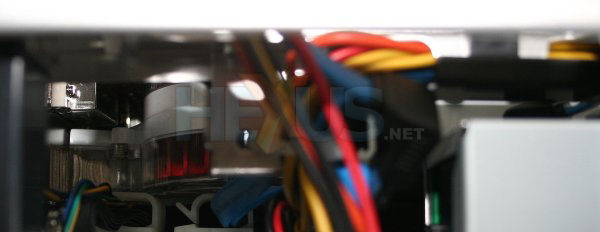More thoughts

Behind the vented cover we see an 80mm exhaust fan that wicks away heat from the copper-bottomed CPU cooler which has a similar, but thinner, intake fan on the other side. The twin 40mm fans, shown on the previous page, then help exhaust the warm air from inside the chassis. Shuttle's excellent BIOS allows you to control the fans' speed via a number of preset parameters. Thermal performance, obviously, needs to be excellent, for the P 2500G features an AMD Athlon 64 FX-60 dual-core CPU; currently the fastest in the S939 range and one that produces a maximum 110W TDP when under full load.
Shuttle has taken advantage of both available DIMM slots and added in 2GBytes of PC3200 RAM. The two 1GByte modules are manufactured by takeMS and run with conservative 3-3-3-8 timings. We've noted many times before that such a high-end processor, FX-60, really shines when paired up with low-latency memory, so Shuttle has made a slight performance sacrifice in specifying these modules. A single 250GB Samsung hard drive is connected via one of the FN25's 4 SATA2 ports, all running from the nForce4 Ultra's SB.
The nForce4 core-logic's southbridge utilises basic AC'97 audio. Thankfully, Shuttle adds a VIA Envy24PT audio controller for better sound, and given the fact that the only expansion slot is blocked by the double-height ATI graphics card, this can only be considered as a good move.

The opposite side highlights the amount of room taken up by a Connect3D Radeon X1900 XTX 512MB PCIe graphics card. The large heatsink and cooler precludes the use of the one PCIe expansion slot on offer, and there's absolutely no chance of fitting another card into the case.

Notice the extremely snug fit of the card into the chassis? Whilst the cooler's fan is louder than we'd like, something that Shuttle cannot do much about, the heatsink is designed to exhaust the warm air from the GPU out towards the back of the chassis.
In the end, what you get is a gaming system that's scarily powerful. Shuttle has meshed together an Athlon 64 FX-60, 2GBytes of DDR400 RAM, and a Radeon X1900 XTX 512MB graphics card into a SFF system that's not much larger than a shoebox. Whatever your thoughts on the usefulness of SFF-based systems, there's no denying that there's power to be had in spades, and large ones at that.
Noise and usage
Shuttle has used its fourth-generation I.C.E cooling with the SN25P. Couple that in with a BIOS that allows you to control fan speeds and a well-designed chassis that acts as a large heatsink, and noise, really, isn't much of an issue. We set the fan-speed regulation to SmartFan and found the system to be extremely quiet under load, with the graphics card's cooling creating the greatest noise. Top marks to Shuttle for engineering a quiet system that's also powerful.The SN25P carries Shuttle SilentX 350W PSU. On paper, its rating seems a little on the low side, in view of the graphics card and CPU chosen here. However, the unit passed a 12-hour burn-in test without any problems, suggesting, once again, that quality can count for more than quantity.
Software and bundle
Shuttle's O.S. of choice for this high-end system was Microsoft XP Pro SP2. Further, it added Nero AG's OEM Suite (CD/DVD-burnin' software) and CyberLink's PowerDVD: we guess they ship with the retail products. We'd expect a touch more on this front, perhaps a cutting-edge game or two, to make the most of the Radeon X1900 XTX's rendering ability. You'll also have to invest in a Works-type suite yourself, which seems stingy considering the asking price of £2,199 for the base unit.Warranty details
Shuttle's first-line support is available through a freephone telephone number. Basic problems can be addressed and if Shuttle deems that the unit requires inspection, it offers a 2-year collect-and-return service that aims to turnaround systems, from initial pickup to return delivery, within 7 working days. We, however, reckon a 3-year warranty should be standard for high-end systems.Value for money?
Is it worth it? Should you desire to do so, it's relatively simple to build this kind of system yourself. We specified an identical system from a popular e-tailer and came up with an all-inclusive price of £1650. Of course, that excludes the time taken to build and configure the system yourself (which is often the best part), as well as professional warranty support offered by Shuttle.However, even with that taken into account, we reckon the £2,199 asking price is too high, especially given the fact that established system integrators often offer SKUs at prices that cost less than the combined price of the parts, if bought via the retail channel. There's little doubting that this SKU features quality parts, yet, we feel, the price needs to drop by at least £300 for it to offer significant value for money.
Prospective buyers will need to add their own screen, keyboard, mouse and speakers of their choice, too. Shuttle also offers upgrades for certain parts, with its own TFTs heading the list. Larger hard drives are also available and there's a possibility of adding in a WLAN module for an extra £50 or so. We'd like to see this kind of high-end base unit ship with WiFi as standard. Is that being too harsh?









